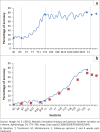Exploring the efficacy of melodic intonation therapy with Broca's aphasia in Arabic
- PMID: 29943587
- PMCID: PMC6018128
- DOI: 10.4102/sajcd.v65i1.567
Exploring the efficacy of melodic intonation therapy with Broca's aphasia in Arabic
Abstract
Even though the efficacy of melodic intonation therapy (MIT) with persons with aphasia (PWA) has been explored in different languages, the efficacy of MIT with Arabic-speaking PWA has never been explored. Aims: To explore the efficacy of MIT, adapted to Arabic, in promoting the expressive abilities of a 70-year-old Jordanian Arabic-speaking male subject with severe Broca's aphasia 3 months post-onset. Methods: An 8-week MIT therapy programme with tapping (1.5 h daily, 6 days a week) was used in a multiple baseline design across two types of trained phrases (i.e. automatic and self-generated phrases). Outcome measures included accuracy of production of trained (at the end of each session) and untrained phrases (at the end of each week). Pre- and post-treatment measures used, were the bilingual aphasia test, the American Speech-Language Hearing Association Functional Assessment of Communicative Skills, the communicative effectiveness index and the American Speech and Hearing Association Quality of Communication Life Scale. Accuracy of production for the trained and untrained phrases was also measured 2 weeks and 4 weeks after the treatment programme was finished. Results: The patient, (MK), improved his expressive productions post-treatment in automatic and self-generated phrases. Automatic phrases exceeded the established 75% accuracy criterion, whereas the self-generated phrases reached criterion and remained constant at follow-up. Moreover, MK gradually started improving on the generalisation stimuli, once the treatment on the self-generated phrases started and maintained the gains 2 weeks and 4 weeks post-treatment. Conclusion: MIT appears to be a viable treatment option for Jordanian Arabic-speaking persons with Broca's aphasia. However, more research is needed with larger groups of Jordanian Arabic-speaking persons with Broca's aphasia to provide more support to the present findings. Moreover, future studies might focus on the efficacy of MIT with persons with Broca's aphasia from different Arab countries and from countries where Arabic is part of the multicultural structure like South Africa and other countries on the African continent.
Keywords: Arabic; Broca’s aphasia; Melodic Intonation Therapy.
Conflict of interest statement
The authors declare that they have no financial relationships that may have inappropriately influenced them in writing this article.
Figures

Similar articles
-
Effectiveness of a Verbal Expressive Skills Management Program for Pakistani Patients with Broca Aphasia: A Randomized Clinical Trial.Altern Ther Health Med. 2023 Sep;29(6):204-208. Altern Ther Health Med. 2023. PMID: 37295011 Clinical Trial.
-
The Combination of Rhythm and Pitch Can Account for the Beneficial Effect of Melodic Intonation Therapy on Connected Speech Improvements in Broca's Aphasia.Front Hum Neurosci. 2014 Aug 11;8:592. doi: 10.3389/fnhum.2014.00592. eCollection 2014. Front Hum Neurosci. 2014. PMID: 25157222 Free PMC article.
-
The Efficacy and Timing of Melodic Intonation Therapy in Subacute Aphasia.Neurorehabil Neural Repair. 2014 Jul;28(6):536-44. doi: 10.1177/1545968313517753. Epub 2014 Jan 20. Neurorehabil Neural Repair. 2014. PMID: 24449708 Clinical Trial.
-
Melodic intonation therapy: back to basics for future research.Front Neurol. 2014 Jan 28;5:7. doi: 10.3389/fneur.2014.00007. eCollection 2014. Front Neurol. 2014. PMID: 24478754 Free PMC article. Review.
-
Melodic Intonation Therapy for aphasia: A multi-level meta-analysis of randomized controlled trials and individual participant data.Ann N Y Acad Sci. 2022 Oct;1516(1):76-84. doi: 10.1111/nyas.14848. Epub 2022 Aug 2. Ann N Y Acad Sci. 2022. PMID: 35918503 Free PMC article. Review.
Cited by
-
Arabic Aphasia Research Through a Clinical and Linguistic Lens: A Systematic Review of Current Limitations and Future Directions.Int J Lang Commun Disord. 2025 Jul-Aug;60(4):e70064. doi: 10.1111/1460-6984.70064. Int J Lang Commun Disord. 2025. PMID: 40522296 Free PMC article. Review.
-
Melodic Intonation Therapy for Post-stroke Non-fluent Aphasia: Systematic Review and Meta-Analysis.Front Neurol. 2021 Aug 4;12:700115. doi: 10.3389/fneur.2021.700115. eCollection 2021. Front Neurol. 2021. PMID: 34421802 Free PMC article.
References
-
- Adam H. (2014). Verb and noun production in Aphasia: Evidence from Palestinian Arabic. International Journal of Brain and Cognitive Sciences, 3(1), 1–5. https://doi.org/10.5923/j.ijbcs.20140301.01 - DOI
-
- Albert M. L., Sparks R. W., & Helm N. A. (1973). Melodic intonation therapy for aphasia. Archives of Neurology, 29(2), 130–131. https://doi.org/10.1001/archneur.1973.00490260074018 - DOI - PubMed
-
- Albustanji Y. M., Milman L. H., Fox R. A., & Bourgeois M. S. (2013). Agrammatism in Jordanian-Arabic speakers. Clinical Linguistics & Phonetics, 27(2), 94–110. https://doi.org/10.3109/02699206.2012.742568 - DOI - PubMed
-
- Bonakdarpour B., Eftekharzadeh A., & Ashayeri H. (2003). Melodic intonation therapy in Persian aphasic patients. Aphasiology, 17(1), 75–95. https://doi.org/10.1080/729254891 - DOI
-
- Brust J. C. M. (2003). The cognitive neuroscience of music In Peretz I. & Zatorre R. (Eds.), Music and Neurologist: A historical perspective (pp. 181–191). Great Britain: Oxford University Press.
Publication types
MeSH terms
LinkOut - more resources
Full Text Sources
Other Literature Sources
